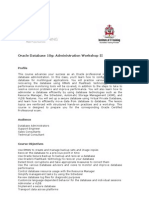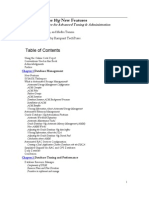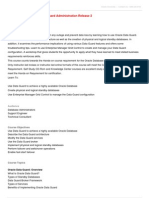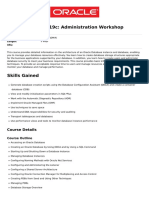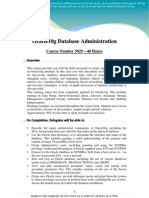Oracle Database 10g: Administration Workshop II Release 2: Duration
Oracle Database 10g: Administration Workshop II Release 2: Duration
Uploaded by
adiseshupCopyright:
Available Formats
Oracle Database 10g: Administration Workshop II Release 2: Duration
Oracle Database 10g: Administration Workshop II Release 2: Duration
Uploaded by
adiseshupOriginal Title
Copyright
Available Formats
Share this document
Did you find this document useful?
Is this content inappropriate?
Copyright:
Available Formats
Oracle Database 10g: Administration Workshop II Release 2: Duration
Oracle Database 10g: Administration Workshop II Release 2: Duration
Uploaded by
adiseshupCopyright:
Available Formats
Oracle University | Contact Us: 1.800.529.
0165
Oracle Database 10g: Administration Workshop II Release 2
Duration: 5 Days What you will learn This course advances your success as an Oracle professional in the area of database administration. In this class, you'll learn how to configure an Oracle database for multilingual applications. You will practice various methods of recovering the database using RMAN and Flashback technology. Database performance monitoring tools will be covered, in addition to the steps to take to resolve common problems and improve performance. You will also learn how to administer a database efficiently by using database technologies such as the Resource Manager, the Scheduler, Automatic Storage Management (ASM), and VLDB features. You will set up a secure database using Virtual Private Database, and learn how to efficiently move data from database to database. The lesson topics are reinforced with structured hands-on practices and a workshop. This course is designed to prepare you for the corresponding Oracle Certified Professional exam.This course counts towards the Hands-on course requirement for the Oracle Database 10g Administrator Certification. Only instructor-led inclass or instructor-led online formats of this course will meet the Certification Hands-on Requirement. Self Study CD-Rom and Knowledge Center courses are excellent study and reference tools but DO NOT meet the Hands-on Requirement for certification. Database Administrators Sales Consultants Support Engineer Technical Consultant
Prerequisites Required Prerequisites Knowledge of basic database administration
Suggested Prerequisites Oracle Database: SQL and PL/SQL Fundamentals Oracle Database 10g: Administration Workshop I Release 2 Course Objectives Use RMAN to create and manage backup sets and image copies Recover the database to a previous point in time Use Oracle Secure Backup to backup and recover a database Use Oracle's Flashback technology to recover your database Detect block corruptions and take appropriate measures to correct them Use the various Database advisors and views to monitor and improve database performance Control database resource usage with the Resource Manager Simplify management tasks by using the Scheduler Review database log files for diagnostic purposes Customize language-dependent behavior for the database and individual sessions Administer a VLDB Implement a secure database Transport data across platforms
Copyright 2011, Oracle. All rights reserved.
Page 1
Course Topics Introduction Grid Computing Oracle Enterprise Manager 10g Product Controls Database Architecture Review Configuring Recovery Manager Recovery Manager Features and Components Using a Flash Recovery Area with RMAN Configuring RMAN Control File Autobackups Retention Policies and Channel Allocation Using Recovery Manager to connect to a target database in default NOCATALOG mode Displaying the current RMAN configuration settings Altering the backup retention policy for a database Using Recovery Manager RMAN Command Overview Parallelization of Backup Sets Compressed Backups Image Copy Whole Database and Incremental Backups LIST and REPORT commands Enable ARCHIVELOG mode for the database Use Recovery Manager Oracle Secure Backup Installation and Configuration Implement the Oracle suggested strategy RMAN and Oracle Secure Backup Database and File-system files backup/restore to tape Using obtool and web interface to configure Oracle Secure Backup devices (CLI/GUI) Configuring EM for Oracle Secure Backup and test backup to tape (EM) Using RMAN to backup your database to tape (CLI) Using the OB Web tool to backup file system files Recovering from Non-critical Losses Recovery of Non-Critical Files Creating New Temporary Tablespace Recreating Redo Log Files, Index Tablespaces, and Indexes Read-Only Tablespace Recovery Authentication Methods for Database Administrators Loss of Password Authentication File Creating a new temporary tablespace Altering the default temporary tablespace for a database Incomplete Recovery Recovery Steps Server and User Managed Recovery commands Recovering a Control File Autobackup Creating a New Control File
Copyright 2011, Oracle. All rights reserved.
Page 2
Incomplete Recovery Overview Incomplete Recovery Best Practices Simplified Recovery Through RESETLOGS Point-in-time recovery using RMAN Flashback Flashback Database Architecture Configuring and Monitoring Flashback Database Backing Up the Flash Recovery Area Using V$FLASH_RECOVERY_AREA_USAGE Flashback Database Considerations Using the Flashback Database RMAN interface Using Flashback Database EM Interface Managing and monitoring Flashback Database operations Dealing with Database Corruption Block Corruption Symptoms: ORA-1578 DBVERIFY Utility and the ANALYZE command Initialization parameter DB_BLOCK_CHECKING Segment Metadata Dump and Verification Using Flashback for Logical Corruption and using DBMS_REPAIR Block Media Recovery RMAN BMR Interface Dumping and Verifying Segment Metadata Monitoring and Managing Memory Oracle Memory Structures Automatic Shared Memory Management SGA Tuning Principles Database Control and Automatic Shared Memory Management Behavior of Auto-Tuned and Manual SGA Parameters Resizing SGA_TARGET PGA Management Resources Using the Memory Advisor Automatic Performance Management Identifying Tunable Components Oracle Wait Events and System Statistics Troubleshooting and Tuning Views Direct Attach to SGA for Statistic Collection Workload Repository Advisory Framework ADDM Scenarios and Usage Tips Using the SQL Tuning and SQL Access Advisor Monitoring and Managing Storage I Database Storage Structures Space Management Overview Oracle-Managed Files (OMF) Row Chaining and Migrating Proactive Tablespace Monitoring Managing Resumable Space Allocation
Copyright 2011, Oracle. All rights reserved.
Page 3
SYSAUX Tablespace Monitoring table and index space usage Monitoring and Managing Storage II Automatic Undo Management Redo Log Files Table Types Partitioned Tables Index-Organized Tables (IOT) Managing index space with SQL Configure optimal redo log file size View Automatic Tuning of Undo Retention Automatic Storage Management ASM General Architecture and Functionalities Dynamic Performance View Additions Managing an ASM Instance ASM Disk Groups Using asmcmd Command Line Migrating Your Database to ASM Storage Creating an ASM instance in a separate Oracle Home Migrating a tablespace to use ASM storage VLDB Support Creating Bigfile Tablespaces Packages and data dictionary changes to support VLDB Creating and maintaining temporary tablespace groups (TTG) Partitioning and Partitioned Indexes Skipping unusable indexes Creating and using hash-partitioned global indexes DML Error Logging Interpreting Bigfile ROWIDs Managing Resources Database Resource Manager Concepts and Configuration Creating a New Resource Plan Active Session Pool Mechanism Maximum Estimated Execution Time Creating a Complex Plan Administering and Monitoring Resource Manager Resource Plan Directives Creating Resource Consumer Groups Automating Tasks with the Scheduler Scheduler Concepts Creating a Job Class and a Window Managing Jobs, Programs, Chains, Events, Schedules, priority Viewing and Purging Job Logs Creating a program and a schedule Creating a job that uses a program and a schedule Altering the program and schedule for the job and observing the behavior change of the job Monitoring job runs
Copyright 2011, Oracle. All rights reserved.
Page 4
Database Security Virtual Private Database: Overview Creating a Column-Level Policy Writing a Policy Function Policy Types Column level VPD with column masking Transparent Data Encryption Setting the listener password Implement VPD Data Movement External Tables Concepts Creating a Directory object and External Table Data Pump Transport Database RMAN CONVERT DATABASE Command Transport Tablespace Create a Directory Object Create a Temporary Table Using Globalization Support Globalization Support Features Encoding Schemes Database Character Sets and National Character Sets Specifying Language-Dependent Behavior Locale Variants Using Linguistic Comparison and Sorting Data Conversion Between Client and Server Character Sets Determining the Default NLS Settings Workshop Workshop Methodology, requirements, and setup Scenario 1: Database performance Scenario 2: Finding and Tuning Inefficient SQL Scenario 3: SGA Management - REDO Scenario 4: Running out of Undo Space Scenario 5: Missing datafile Scenario 6: Managing space in a tablespace - REDO Scenario 7: Missing TEMP data file
Related Courses Oracle Database 10g: Administration Workshop II Self-Study CD Course
Copyright 2011, Oracle. All rights reserved.
Page 5
You might also like
- Oracle Database 10g Administration Workshop II Release 2Document5 pagesOracle Database 10g Administration Workshop II Release 2vsrao74No ratings yet
- Oracle Database 10 G: Administration Workshop I Release 2: What You Will LearnDocument8 pagesOracle Database 10 G: Administration Workshop I Release 2: What You Will LearngdbhootNo ratings yet
- Oracle Database 11gDocument7 pagesOracle Database 11gVishy AnandNo ratings yet
- Oracle DBA Training in ChennaiDocument10 pagesOracle DBA Training in ChennaiTrain TNo ratings yet
- Oracle Database 11g: Administration Workshop I DBA Release 2Document5 pagesOracle Database 11g: Administration Workshop I DBA Release 2Feleke AfeworkNo ratings yet
- Oracle Database 10g Administration Workshop IIDocument3 pagesOracle Database 10g Administration Workshop IIskbiswal2007No ratings yet
- Oracle Database 11g - Administration Workshop IIDocument5 pagesOracle Database 11g - Administration Workshop IIsonicefuNo ratings yet
- Oracle DBA SyllabusDocument8 pagesOracle DBA SyllabusanilpalacherlaNo ratings yet
- D50079GC20 1080544 UsDocument5 pagesD50079GC20 1080544 Uspriya_psalmsNo ratings yet
- Oracle Database 12c Administration Workshop D78846GC10Document5 pagesOracle Database 12c Administration Workshop D78846GC10bugzbinnyNo ratings yet
- Oracle Database 11g Administration Workshop II Release 2 - D50079GC20 - 1080544 - USDocument5 pagesOracle Database 11g Administration Workshop II Release 2 - D50079GC20 - 1080544 - USJinendraabhiNo ratings yet
- Oracle Database 12c Admin, Install and Upgrade Accelerated - D79027GC10 - 1080544 - USDocument6 pagesOracle Database 12c Admin, Install and Upgrade Accelerated - D79027GC10 - 1080544 - USJinendraabhiNo ratings yet
- Oracle DBA Workshop IIDocument4 pagesOracle DBA Workshop IIpgupta101No ratings yet
- D78846GC20 PDFDocument5 pagesD78846GC20 PDFBugz BinnyNo ratings yet
- Oracle Database 11g: New Features For Administrators DBA Release 2Document5 pagesOracle Database 11g: New Features For Administrators DBA Release 2mihir_karmakarNo ratings yet
- Oracle 10g Admin 1Document4 pagesOracle 10g Admin 1Syed Oneeb JafriNo ratings yet
- Oracle 11g DBA PLSQL LINUX Course ContentDocument12 pagesOracle 11g DBA PLSQL LINUX Course Contentsaravanand1983No ratings yet
- Oracle Database 11g Administration Workshop I Release 2 - D50102GC20 - 1080544 - USDocument5 pagesOracle Database 11g Administration Workshop I Release 2 - D50102GC20 - 1080544 - USJinendraabhiNo ratings yet
- Training TopicsDocument5 pagesTraining Topicskrishna.setwinNo ratings yet
- Oracle Database 12c Admin Install and Upgrade Accelerated NEW D79027GC10Document6 pagesOracle Database 12c Admin Install and Upgrade Accelerated NEW D79027GC10vineetNo ratings yet
- OCM Certification Exam TopicDocument3 pagesOCM Certification Exam TopicBalaji JayaramanNo ratings yet
- Oracle Database 11g New Features For Administrators DBA Release 2 - D50081GC20 - 1080544 - USDocument5 pagesOracle Database 11g New Features For Administrators DBA Release 2 - D50081GC20 - 1080544 - USJinendraabhiNo ratings yet
- Oracle Database 12c Administration Workshop Ed 2Document6 pagesOracle Database 12c Administration Workshop Ed 2Adonis Prince NaniNo ratings yet
- Oracle DBADocument25 pagesOracle DBAAvinash SinghNo ratings yet
- Oracle Database 12c R2: Administration Workshop Ed 3: DurationDocument6 pagesOracle Database 12c R2: Administration Workshop Ed 3: DurationBugz Binny100% (1)
- Oracle Database 12c - Administration Workshop Ed 2Document6 pagesOracle Database 12c - Administration Workshop Ed 2AjinkyaSoitkar100% (1)
- Oracle Database 12c Fundamentals For Developers and System Administrators NEW D79228GC10Document4 pagesOracle Database 12c Fundamentals For Developers and System Administrators NEW D79228GC10vineetNo ratings yet
- Oracle DBA 11g@Training@DBA School HyderabadDocument10 pagesOracle DBA 11g@Training@DBA School HyderabadpsdbaNo ratings yet
- Oracle Database 11g-Administration Workshop I - D50102GC10Document3 pagesOracle Database 11g-Administration Workshop I - D50102GC10kbr63No ratings yet
- Oracle Database 12c Backup and Recovery Workshop Ed 2Document6 pagesOracle Database 12c Backup and Recovery Workshop Ed 2Manuel Elizalde100% (1)
- GDocument7 pagesGCyro BezerraNo ratings yet
- Oracle Database 12c R2: Administration Workshop Ed 3: DurationDocument6 pagesOracle Database 12c R2: Administration Workshop Ed 3: Durationjackomito100% (1)
- D50081GC20 1080544 UsDocument3 pagesD50081GC20 1080544 UsvineetNo ratings yet
- D78850GC10 28 UsDocument5 pagesD78850GC10 28 UsvineetNo ratings yet
- Oracle Database 10g New FeaturesDocument35 pagesOracle Database 10g New FeaturesSaket BhandareNo ratings yet
- Oracle Database 12c Administration Workshop Ed 2Document7 pagesOracle Database 12c Administration Workshop Ed 2Nasir AliNo ratings yet
- Database - Oracle Database 12c R2 - Administration Workshop Ed 3 - Oracle UniversityDocument6 pagesDatabase - Oracle Database 12c R2 - Administration Workshop Ed 3 - Oracle UniversityMiguel Alfonso DIAZ MORRISNo ratings yet
- Oracle DBADocument6 pagesOracle DBAHemanath TadiNo ratings yet
- Oracle Database 11g Implement Database Vault Release 2 - D52474GC20 - 1080544 - USDocument3 pagesOracle Database 11g Implement Database Vault Release 2 - D52474GC20 - 1080544 - USJinendraabhiNo ratings yet
- Oracle Database 11g - Underground Advice for Database Administrators: Beyond the basicsFrom EverandOracle Database 11g - Underground Advice for Database Administrators: Beyond the basicsNo ratings yet
- Oracle 11g2 TocDocument3 pagesOracle 11g2 TocThota Mahesh DbaNo ratings yet
- D77758GC20 15947 UsDocument6 pagesD77758GC20 15947 UsWilliam Lee0% (1)
- Oracle Database 12c New Features For Administrators Ed 2 NEW - D77758GC20 - 1080544 - USDocument6 pagesOracle Database 12c New Features For Administrators Ed 2 NEW - D77758GC20 - 1080544 - USJinendraabhiNo ratings yet
- Oracle Database 11g: New Features For Administrators: Installation and Upgrade EnhancementsDocument2 pagesOracle Database 11g: New Features For Administrators: Installation and Upgrade EnhancementsloadingxpNo ratings yet
- This Course Is Divided in 2 Parts:: 1. Oracle 10g: Introduction To SQL Ed 3Document2 pagesThis Course Is Divided in 2 Parts:: 1. Oracle 10g: Introduction To SQL Ed 3samratbasucoolNo ratings yet
- Oracle Database 11G: Managing Oracle On Linux For Dbas: DurationDocument3 pagesOracle Database 11G: Managing Oracle On Linux For Dbas: DurationWaseem ParkarNo ratings yet
- Data Gaurd SummaryDocument3 pagesData Gaurd SummaryKamaldeep NainwalNo ratings yet
- Oracle Workshop 1 SyllabusDocument3 pagesOracle Workshop 1 SyllabusAnonymous RyqwFMMuJMNo ratings yet
- Oracle Database 11g Data Guard Administration Release 2 - D52161GC30 - 1080544 - USDocument4 pagesOracle Database 11g Data Guard Administration Release 2 - D52161GC30 - 1080544 - USJinendraabhiNo ratings yet
- Oracle Database 19c Administration WorkshopDocument2 pagesOracle Database 19c Administration WorkshopBugz Binny33% (3)
- O R A C L e 1 0 G D A T A B A S e A D M I N I S T R A T I o NDocument4 pagesO R A C L e 1 0 G D A T A B A S e A D M I N I S T R A T I o NRajendra PrasadNo ratings yet
- Exadata and Database Machine Administration Workshop NEW: DurationDocument4 pagesExadata and Database Machine Administration Workshop NEW: DurationralagarsanNo ratings yet
- Exploring The Oracle Database ArchitectureDocument4 pagesExploring The Oracle Database ArchitectureNguyễnXuânLươngNo ratings yet
- Oracle Database 11g: Administration and SQL Performance Tuning WorkshopDocument3 pagesOracle Database 11g: Administration and SQL Performance Tuning WorkshopSaiNitipatNo ratings yet
- Oracle Database 12c Managing Multitenant ArchitectureDocument4 pagesOracle Database 12c Managing Multitenant ArchitecturevineetNo ratings yet
- OCA Oracle Database 11g Database Administration I: A Real-World Certification GuideFrom EverandOCA Oracle Database 11g Database Administration I: A Real-World Certification GuideRating: 4 out of 5 stars4/5 (1)
- Oracle Database 12c Backup and Recovery Survival GuideFrom EverandOracle Database 12c Backup and Recovery Survival GuideRating: 4.5 out of 5 stars4.5/5 (3)
- Oracle Advanced PL/SQL Developer Professional Guide: Master advanced PL/SQL concepts along with plenty of example questions for 1Z0-146 examination with this book and ebookFrom EverandOracle Advanced PL/SQL Developer Professional Guide: Master advanced PL/SQL concepts along with plenty of example questions for 1Z0-146 examination with this book and ebookNo ratings yet





